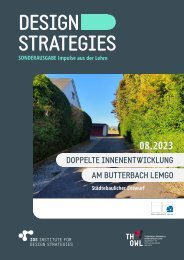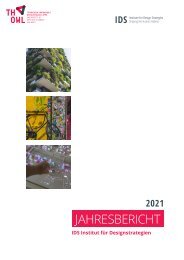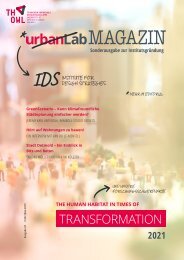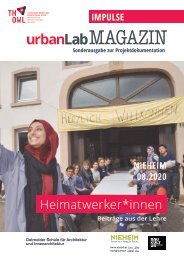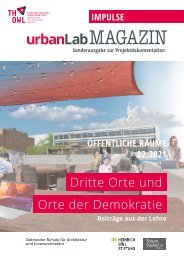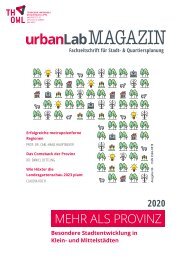Design Strategies IMPULSE - Sustainable Facades Vol 2
Report Winter Semester 2023/24
Report Winter Semester 2023/24
You also want an ePaper? Increase the reach of your titles
YUMPU automatically turns print PDFs into web optimized ePapers that Google loves.
its production, providing strong thermal qualities,<br />
while lime binder adds mechanical capabilities,<br />
making it fire, rot, and insect-resistant. Although<br />
it can possess favorable compressive strength,<br />
hempcrete is not suitable for load-bearing<br />
structures but is commonly used as infill in<br />
construction [3].<br />
Strength:<br />
shifted upwards, leaving an overlap to prevent<br />
spillage. Hempcrete walls are framed with 2×4s at<br />
24-inch spacing, with potential wood use reduction<br />
under engineer‘s guidance. Once cured, lime plaster<br />
is applied internally and externally, with fiberglass<br />
mesh reinforcing the exterior. Additional rain<br />
protection may include a face brick splash guard on<br />
a zinc shelf at the bottom, topped with flashing for a<br />
seamless joint with plaster.<br />
Figure 22. Rehabilitation with straw bales<br />
• High rot, and insect resistance<br />
• Hemp-lime buildings may collect roughly<br />
165 kg of CO2 per m3. (manufacturers ‘Lime<br />
Technology Ltd and Technichanvre)<br />
• There are no solid wastes generated during<br />
construction.<br />
• Structural element, good thermal and<br />
acoustic insulation, can be cast into any<br />
shape.<br />
5.3 Prefab hempcrete panel<br />
Using prefabricated hemp panels for construction<br />
offers a more efficient and faster alternative to<br />
traditional on-site builds, reducing construction<br />
time and eliminating the 45-day curing period<br />
required for cast hempcrete buildings. These<br />
panels, filled with hempcrete mixture, utilize 3-ft by<br />
Weakness:<br />
plaster is ideal for interior finishes, regulating indoor<br />
moisture. Builders often include a „Truth Window“ to<br />
showcase straw bale construction, revealing a piece<br />
of straw within the wall.<br />
Recycle and Reuse<br />
Straw bale walls and panels offer environmentally<br />
friendly building materials that can be recycled<br />
and reused in various ways. Recycling begins<br />
with careful deconstruction, separating<br />
straw from extraneous components like<br />
plaster or wood framework. The straw can be<br />
repurposed for animal bedding, mulch, or soil<br />
amendment, while the plaster and wood can<br />
also be recycled. If in good condition, straw<br />
bales may be reused for earth-building like<br />
Adobe construction.<br />
5. Hemp-lime products<br />
Figure 23. Truth window<br />
Hemp-lime, also known as „hempcrete,“ is a<br />
bio-composite material made from lime-based<br />
binders and hemp shiv. It offers strength, thermal<br />
efficiency, and versatility, suitable for monolithic<br />
walls or insulating bricks and blocks. Originating<br />
in France, about 15% of hemp shives are used in<br />
• The material must be well sheltered from<br />
frost and severe rain during construction,<br />
and the outside temperature must not drop<br />
below 5°C.<br />
• Protective clothing, gloves, and other gear<br />
are necessary when handling hemp-lime due<br />
to its skin and eye irritant properties, as well<br />
as the potential to cause burns when damp.<br />
• To maintain proper plaster coating and wall<br />
finishes, maintenance is frequently required.<br />
Hemp-lime products come in blocks, precast<br />
elements, and in situ cast forms. In-situ<br />
application involves molding or spraying it<br />
around the building‘s structural frame. Blocks<br />
are available in structural and thermal varieties,<br />
while precast panels are filled with hemp-lime<br />
and hung on steel, timber, or concrete frames,<br />
providing insulation and an airtight enclosure for<br />
buildings.<br />
5.1 The hempcrete block<br />
‚Isohemp‘ provides hemp blocks, a non-loadbearing<br />
glued masonry product suitable for<br />
various construction purposes such as residential<br />
houses, wall doubling, industrial partitioning, and<br />
apartments. They offer two types: solid blocks and<br />
machined blocks. Solid hemp blocks are 60cm by<br />
Figure 24. Hempcrete blocks<br />
30cm, and available in thicknesses from 6 to 36cm.<br />
Machined blocks include holed and U-shaped<br />
blocks with thicknesses of 30 and 36cm.<br />
Hempro System<br />
The Hempro System by ‚Isohemp‘ utilizes two types<br />
of 30cm thick hemp blocks: solid and machined.<br />
Machined blocks serve as insulating lost formwork<br />
within the building envelope for pouring reinforced<br />
concrete structural frames. Holed blocks form<br />
column formwork, while U-blocks facilitate beam<br />
pouring to support floors and roofs. Additional<br />
hemp block layers of varying thicknesses can be<br />
added for enhanced thermal performance.<br />
5.2 The hempcrete formwork<br />
On-site hempcrete walls are constructed by<br />
blending hemp hurd (the woody core of the hemp<br />
plant), a binder (such as lime or cement), and water.<br />
This mixture produces a durable and lightweight<br />
material suitable for both load-bearing and nonload-bearing<br />
walls in construction.<br />
Construction Process<br />
Figure 25. : Hempro system<br />
‘Hempstone,‘ a professional hempcrete installer,<br />
outlined the construction process for Hempcrete<br />
Formwork. To prevent moisture absorption from the<br />
ground, plastic membrane strips are placed directly<br />
on the slab with spray foam insulation sealing any<br />
cracks. Small PVC conduits on 2” x 4” studs create<br />
an interior barrier, acting as spacers for plywood<br />
formwork. T1-11 siding serves as the outer barrier,<br />
secured with 5-inch<br />
screws into studs, forming a 6.5-inch cavity for<br />
hempcrete. After filling the mold with<br />
hempcrete mix, the formwork is unscrewed and<br />
Figure 26. Hempcrete formwork<br />
Figure 27. Prefab hempcrete panel<br />
22<br />
ARTICLES<br />
<strong>Design</strong> <strong>Strategies</strong> <strong>IMPULSE</strong> – <strong>Sustainable</strong> Façades 04.2024 <strong>Design</strong> <strong>Strategies</strong> <strong>IMPULSE</strong> – <strong>Sustainable</strong> Façades 04.2024<br />
ARTICLES<br />
23









